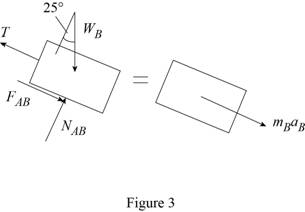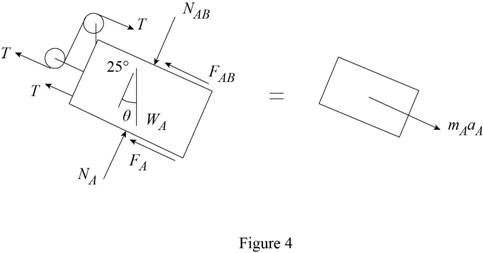
Concept explainers
Block A has a mass of 40 kg, and block B has a mass of 8 kg. The coefficients of friction between all surfaces of contact are μs = 0.20 and μk = 0.15. If P = 0, determine (a) the acceleration of block B, (b) the tension in the cord.
Fig. P12.18 and P12.19

(a)
Find the acceleration of block B.
Answer to Problem 12.19P
The acceleration of block B is
Explanation of Solution
Given information:
The mass of block A
The mass of block B
The coefficient of static friction between all surfaces of contact
The coefficient of kinetic friction between all surfaces of contact
The horizontal load (P) is 40 N.
Calculation:
Write the general equation of weight (W):
Here, m is the mass, g is the acceleration due to gravity.
Consider the constraint of chord.
Write total length of cable connecting block A and block B.
Here,
Differentiate Equation (1) with respect to t to write velocity of the blocks.
Here,
Differentiate Equation (2) with respect to t to write acceleration of the blocks.
Here,
Find the equation of acceleration of block B in terms of acceleration of block A.
Here,
Substitute
First of all determine whether the blocks will move for the given value of
Sketch the free body diagram of block B as shown in Figure 1.

Refer Figure (1),
Consider equilibrium along y-axis .
Here,
Substitute
Write the equation of frictional force
Substitute 0.20 for
Consider equilibrium along x-axis.
Substitute
Substitute 8 kg for
Sketch the free body diagram of block A as shown in Figure (2).

Refer Figure (2).
Consider equilibrium along y-axis.
Here,
Substitute
Write the equation of frictional force
Substitute 0.20 for
Consider equilibrium along x-axis.
Substitute
Substitute 40 kg for
Find the force P for impending motion.
Equate Equation (5) and (6).
The force P of impending motion is less than the
Sketch the free body diagram and kinetic diagram of block B as shown in Figure (3).

Refer Figure (3),
Consider equilibrium along y-axis .
Substitute
Write the equation of frictional force
Substitute 0.15 for
Apply Newton’s law of motion along x-axis.
Substitute
Substitute 8 kg for
Sketch the free body diagram and kinetic diagram of block A as shown in Figure 4.

Refer Figure (4).
Consider equilibrium along y-axis.
Substitute
Write the equation of frictional force
Substitute 0.15 for
Apply Newton’s law of motion along x-axis.
Substitute
Substitute 40 kg for
Find the acceleration of block B
Equate equation (7) and (8).
Negative sign indicates the motion of block B in opposite to x-axis.
Thus, the acceleration of block B is
(b)
Find the tension in the cord.
Answer to Problem 12.19P
The tension in the cord is
Explanation of Solution
Calculation:
Find the tension in the cord using Equation (8).
Substitute
Thus, the tension in the cord is
Want to see more full solutions like this?
Chapter 12 Solutions
Vector Mechanics for Engineers: Statics and Dynamics
Additional Engineering Textbook Solutions
Applied Statics and Strength of Materials (6th Edition)
Thermodynamics: An Engineering Approach
Thinking Like an Engineer: An Active Learning Approach (4th Edition)
Engineering Mechanics: Statics
Vector Mechanics for Engineers: Dynamics
Engineering Mechanics: Statics
- A truck is traveling down a road with a 4-percent grade at a speed of 60 mi/h when its brakes are applied to slow it down to 20 mi/h. An antiskid braking system limits the braking force to a value at which the wheels of the truck are just about to slide. Knowing that the coefficient of static friction between the road and the wheels is 0.60, determine the shortest time needed for the truck to slow down.arrow_forwardA rope having a weight per unit length of 0.4 lb/ft is wound 2 1/2 Times around a horizontal rod. Knowing that the coefficient of static friction between the rope and the rod is 0.30, determine the minimum length x of rope that should be left hanging if a 100-lb load is to be supported.arrow_forwardThe coefficients of friction between the load and the flatbed trailer shown are μs = 0.40 and μk = 0.35. Knowing that the speed of the rig is 55 mi/h, determine the shortest time in which the rig can be brought to a stop if the load is not to shift.arrow_forward
- Baggage on the floor of the baggage car of a high-speed train is not prevented from moving other than by friction. The train is traveling down a 5-percent grade when it decreases its speed at a constant rate from 120 mi/h to 60 mi/h in a time interval of 12 s. Determine the smallest allowable value of the coefficient of static friction between a trunk and the floor of the baggage car if the trunk is not to slide.arrow_forwardA tractor-trailer rig with a 2000-kg tractor, a 4500-kg trailer, and a 3600-kg trailer is traveling on a level road at 90 km/h. The brakes on the rear trailer fail, and the antiskid system of the tractor and front trailer provide the largest possible force that will not cause the wheels to slide. Knowing that the coefficient of static friction is 0.75, determine (a) the shortest time for the rig to a come to a stop, (b) the force in the coupling between the two trailers during that time. Assume that the force exerted by the coupling on each of the two trailers is horizontal.arrow_forwardThree packages each of weight m = 9 kg A, B, and C are placed on a conveyor belt that is at rest. Between the belt and both packages A and C, the coefficients of friction are Ms = 0.30 and Mk = 0.20; between package B and the belt, the coefficients are Ms = 0.10 and Mk = 0.08. The packages are placed on the belt so that they are in contact with each other and at rest. Determine which, if any, of the packages will move and the friction force acting on each package. The frictional force acting on A is N The frictional force acting on B is N The frictional force acting on C is N Note: please show correct step by step working out. And double check final answers. Also for frictional force A, B & C show their directions as well. Thanks!arrow_forward
- NEED WITHIN 1HR PLEASE, THANKS 1. A 1200-kg automobile is moving at a speed of 90 km/h when the brakes are fully applied, causing all four wheels to skid. Determine the time required to stop the automobile on dry pavement (μk = 0.75), and on an icy road (μk = 0.10).arrow_forwardA 2500-lb automobile is moving at a speed of 60 mi/h when the brakes are fully applied, causing all four wheels to skid. Determine the time required to stop the automobile (a) on dry pavement (μk= 0.75), (b) on an icy road (μk= 0.10).arrow_forwardA locomotive exerts a constant force of 200,000 lbs on a set of series-connected railroad cars weighing 5,000,000 lbs and having a total axle friction and rolling resistance of 2,000 lbs. The train travels up a ramp inclined at 20 with an initial velocity of 5 ft/s from point A to point B as shown. The distance from A to B is one mile. Determine the power delivered by the locomotive when it has reached point B.arrow_forward
- Knowing that the coefficients of friction between the component I and member BC of the mechanism of Prob. 12.62 are μk = 0.35 and = 0.25, determine (μk a) the maximum allowable constant speed VB if the component is not to slide on BC while being transferred, (b) the values of 0 for which sliding is impending.Reference to Problem 12.62:arrow_forwardA car is traveling at 100 km/h along a straight, level road when its brakes become locked. Determine the stopping distance of the car knowing that the coefficient of kinetic friction between the tires and the road is 0.65.arrow_forwardThe 554-kg block E is supported by two light parallel links, where = 0.37 m. At what angle (in degrees) should block E be released from rest in order to strike the object F with a speed of v = 1.68 m/s? Object F is struck when = 31.9. Friction is negligible. Choose the correct answer. 73.2 56.5 63.2 66.5 76.5arrow_forward
 Elements Of ElectromagneticsMechanical EngineeringISBN:9780190698614Author:Sadiku, Matthew N. O.Publisher:Oxford University Press
Elements Of ElectromagneticsMechanical EngineeringISBN:9780190698614Author:Sadiku, Matthew N. O.Publisher:Oxford University Press Mechanics of Materials (10th Edition)Mechanical EngineeringISBN:9780134319650Author:Russell C. HibbelerPublisher:PEARSON
Mechanics of Materials (10th Edition)Mechanical EngineeringISBN:9780134319650Author:Russell C. HibbelerPublisher:PEARSON Thermodynamics: An Engineering ApproachMechanical EngineeringISBN:9781259822674Author:Yunus A. Cengel Dr., Michael A. BolesPublisher:McGraw-Hill Education
Thermodynamics: An Engineering ApproachMechanical EngineeringISBN:9781259822674Author:Yunus A. Cengel Dr., Michael A. BolesPublisher:McGraw-Hill Education Control Systems EngineeringMechanical EngineeringISBN:9781118170519Author:Norman S. NisePublisher:WILEY
Control Systems EngineeringMechanical EngineeringISBN:9781118170519Author:Norman S. NisePublisher:WILEY Mechanics of Materials (MindTap Course List)Mechanical EngineeringISBN:9781337093347Author:Barry J. Goodno, James M. GerePublisher:Cengage Learning
Mechanics of Materials (MindTap Course List)Mechanical EngineeringISBN:9781337093347Author:Barry J. Goodno, James M. GerePublisher:Cengage Learning Engineering Mechanics: StaticsMechanical EngineeringISBN:9781118807330Author:James L. Meriam, L. G. Kraige, J. N. BoltonPublisher:WILEY
Engineering Mechanics: StaticsMechanical EngineeringISBN:9781118807330Author:James L. Meriam, L. G. Kraige, J. N. BoltonPublisher:WILEY





